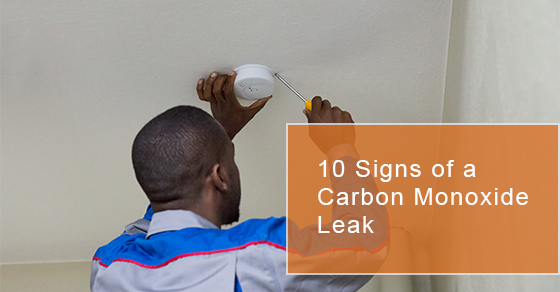
10 Signs of a Carbon Monoxide Leak
Carbon Monoxide (CO) is gas you cannot see or smell which is produced by the incomplete processing of solid, liquid, and gaseous fuels, as well as appliances fueled with oil, liquefied petroleum (LP gas), natural gas, coal, kerosene, or wood. Burning charcoal or running a non-electric machine (car or lawn mower) produces CO gas.
Normally, the small amounts of CO released by heating equipment in the home are vented outside and do not build up inside, but when the air circulating your rooms and heating systems is not properly vented, or when there is a leakage that causes the rate of CO buildup to be greater than that of the venting, the high levels of carbon monoxide displace oxygen in the blood, resulting in CO poisoning – a blockage of normal oxygen delivery to the tissues.
CO is very dangerous, and is often called the “silent killer” because it is hard to detect it until it is too late. Though many victims of CO poisoning recover with treatment, severe cases can cause permanent brain damage.
Protect your home with a Fire Protection package, starting from $25/month.
Signs of a carbon monoxide leak in your house or home
Despite the fact that you can neither smell nor see or taste the gas, there are few signs you can look for to detect a carbon monoxide leakage or buildup in your home, including:
- Dripping or heavy condensation on the windows where the appliance is installed – this can be a great indicator if you have taken measures to reduce moisture production, though it could also imply that the humidifier is set very high
- Sooty or brownish-yellow stains around the leaking appliance
- Stale, stuffy, or smelly air, like the smell of something burning or overheating
- Soot, smoke, fumes, or back-draft in the house from a chimney, fireplace, or other fuel burning equipment
- The lack of an upward draft in chimney flue
- Fallen soot in fireplaces
- Solid fuel fires burning slower than usual
- The smell of unusual gases in your house. While carbon monoxide is odourless, sometimes it is accompanied by exhaust gases you can in fact smell
- A pilot light that is frequently blowing out
- A yellow burner flame instead of the usual clear blue flame, though this is not applicable to natural gas fireplaces that intentionally generate the yellow flame for aesthetic purposes
If you’re late detecting the CO leakage, you may need to take fast action if you notice early symptoms of carbon monoxide poisoning, like tightness across the forehead, followed by pounding of the heart and headache. When progressive poisoning occurs, the victim’s face becomes extremely red accompanied by dizziness, weariness, and mental changes.
However, very concentrated CO may cause the victim to pass out without feeling any of these symptoms.
Carbon Monoxide Safety
The first line of defense against carbon monoxide poisoning is making sure that your home’s heating equipment is being inspected on an annual basis: including gas appliances, chimneys and vents. CO alarms are a good second line of defense that should be installed on every level of the home and tested regularly. Also, you should never use grills, BBQs, or charcoal fuel burners in unventilated spaces, and keep your rooms well ventilated at all times.
Explore our Home Fire Protection packages and learn how you can protect your home from Carbon monoxide and fire.
